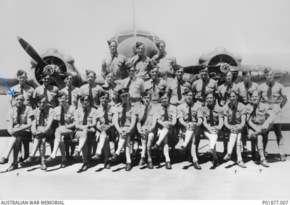
BUDD, Wrinch Joseph Charles
| Service Number: | 406971 |
|---|---|
| Enlisted: | 26 May 1941 |
| Last Rank: | Flying Officer |
| Last Unit: | No. 31 Squadron (RAAF) |
| Born: | Midland Junction, Western Australia., 22 August 1915 |
| Home Town: | Guildford, Swan, Western Australia |
| Schooling: | Not yet discovered |
| Occupation: | Motor Mechanic |
| Died: | Flying Battle, Netherlands East Indies, 6 May 1943, aged 27 years |
| Cemetery: |
No known grave - "Known Unto God" Commemorated ~ Column 8, Ambon Memorial, Maluku, Indonesia. |
| Memorials: | Ambon Memorial, Australian War Memorial Roll of Honour, Guildford War Memorial, Kings Park Western Australia State War Memorial |
World War 2 Service
| 3 Sep 1939: | Involvement Flying Officer, 406971 | |
|---|---|---|
| 26 May 1941: | Enlisted Royal Australian Air Force, Flying Officer, 406971 | |
| 16 Apr 1943: | Transferred Royal Australian Air Force, Flying Officer, No. 31 Squadron (RAAF), Unit: No. 31 Squadron, Coomalie Creek Northern Territory, Australia. |
Help us honour Wrinch Joseph Charles Budd's service by contributing information, stories, and images so that they can be preserved for future generations.
Add my storyBiography contributed by Stephen Bonald
Details of final mission ~~ For some time Japanese float-planes had been intercepting Allied reconnaissance aircraft in the Am Islands area, and the day before the Beaufighter attack a bomber crew had noticed several in the water at Taberfane. Bladin (Air Commodore F. Bladin, Air Officer Commanding North West Area) ordered an immediate attack by available Beaufighter aircraft. Led by Squadron Leader Gordon Walter Savage (168), the Beaufighters flew to Milingimbi airfield where they stayed overnight. Next morning before sunrise they took off and flew in formation through thunderstorms to Taberfane. The float-planes were well silhouetted against the white sand of the beach and two were anchored slightly off shore when the Beaufighters arrived. Savage checked his formation and then began a dive from about 1,300 feet, opening fire with his cannon which set one of the float-planes on fire. A Japanese bullet struck Savage’s machine, passing through the throttle controls and entering the fuel tank. But the self-sealing compound in the tank stopped the petrol leaking When the Beaufighters returned for a second run they saw columns of smoke rising above the float-planes. From then on the pilots passed back and forth and destroyed nine aircraft before all cannons had stopped firing due to faults. When Savage called his flight together again one machine, piloted by Flying Officer Budd (406971), did not join him and he and his navigator (Pilot Officer Finlay McQueen (207758)) were later posted missing.
Extract from Odgers, G.J. (George James) (VX127783) Air War Against Japan 1943-1945, Australian War Memorial, Canberra, 1957 – Pages 50-1











